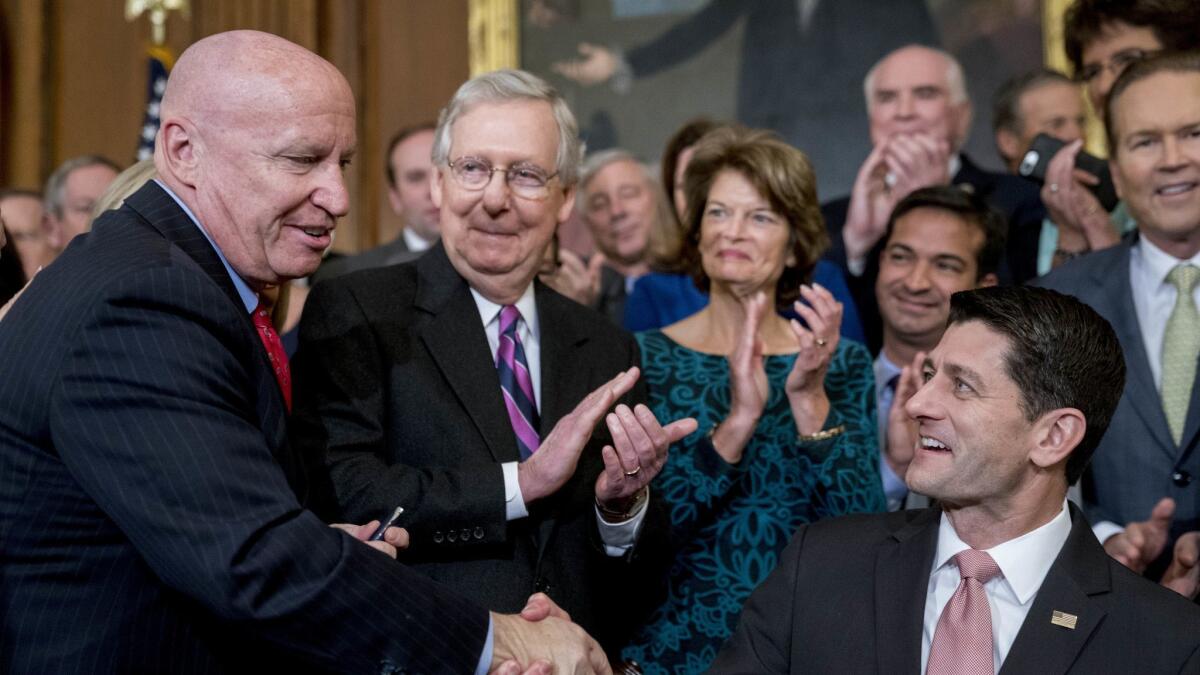Column: Conservatives and business leaders worried about the deficit take aim at Social Security and Medicare

- Share via
One would have thought that after saddling the U.S. economy with a tax cut costing $1.5 trillion over 10 years, conservatives and their patrons in corporate America would soft-pedal the usual attacks on Social Security, Medicare and Medicaid.
One would be wrong.
Recently, the drumbeats for cuts in social insurance benefits have been sounding louder. As is traditional, the call for cutbacks is placed in the context of concern about rising federal deficits. Just two weeks ago, five economists and thinkers at the conservative Hoover Institution evoked the “debt crisis” in the pages of the Washington Post. They attributed the crisis to “sharply rising entitlement spending” in coming years.
It is dishonest to single out entitlements for blame...The primary reason the deficit in coming years will now be higher...[is] last year’s tax cuts.
— Baily, et. al.
“To address the debt problem, Congress must reform and restrain the growth of entitlement programs and adopt further pro-growth tax and regulatory policies,” wrote the Hooverites, Michael J. Boskin, John H. Cochrane, John F. Cogan, George P. Shultz and John B. Taylor. As for the tax cut bill enacted in December, the sages said not to worry: They called it “a good first step, as it sharply increases the incentive to invest and grow businesses, which will increase incomes.”
More on that fatuous assertion in a moment. For now, let’s outsource our calculation of the real cost of the tax cuts to the uncompromising deficit hawks at the Committee for a Responsible Federal Budget. They reckon that the cuts could cost as much as $1.7 trillion over a decade, net of any economic gains it might engender.
The Hoover fellows aren’t alone in calling for cutting social programs, effectively to pay for tax cuts that go overwhelmingly to corporations and the wealthy. We’ve documented how Republicans such as House Speaker Paul Ryan of Wisconsin and Sen. Marco Rubio of Florida started calling for benefit cuts even as the tax bill was making its way through Congress. Just last week, Jamie Dimon, the chairman and chief executive of the giant bank JPMorgan Chase, weighed in on the topic in his annual letter to shareholders. (We covered Dimon’s treatment of healthcare costs in the letter here.)
“The real problem with our deficit is the uncontrolled growth of our entitlement programs,” Dimon wrote. “The extraordinary growth of Medicare, Medicaid and Social Security is jeopardizing our fiscal situation.”
For the record, the Congressional Budget Office projects that Social Security will rise from an average share of 4.9% of gross domestic product now to an average of 5.5% over the next 10 years. Medicare and Medicaid together will rise from 5.4% now to an average of 6.3% in the same period. To place these figures in context, the CBO also expects GDP to nearly double in that time period, to $29.8 trillion.
The tax cuts, by the way, will help push the federal deficit over $1 trillion next year, according to the CBO, which makes clear that they won’t pay for themselves. On Sunday, also in the Washington Post, a group of Democratic economic advisors called foul on the Hooverites’ claim that benefits for the middle class and working class swamp the economy, but tax cuts for the rich are just what the doctor ordered.
“The tax cuts passed last year actually added an amount to America’s long-run fiscal challenge that is roughly the same size as the preexisting shortfalls in Social Security and Medicare,” wrote Martin Neil Baily, Jason Furman, Alan B. Krueger, Laura D’Andrea Tyson and Janet L. Yellen. “It is dishonest to single out entitlements for blame….The primary reason the deficit in coming years will now be higher than had been expected is the reduction in tax revenue from last year’s tax cuts, not an increase in spending.”
As is invariably the case, the brief against “entitlements” is peppered with misconceptions and outright untruths.
Take Dimon’s analysis of Social Security. In his shareholder letter, he asserts that in 1935, “When President Franklin Delano Roosevelt astutely put Social Security in place, ...when someone retired at age 65, the average life span after retirement was 13 years. Today, the average person retires at age 62, and the average life span after retiring is just under 25 years.”
Well, no.
According to the Centers for Disease Control and Prevention, which keeps the statistics, the average life expectancy for a 65-year-old in 1935 (actually, in 1939-41) was 12.8 years — in other words, that average person would be expected to live to 77.8. But the average life expectancy at 65 in 2013, the latest year available, is 19.3 years, not 25. According to the Social Security Administration, in 2014 Americans’ life expectancy at 62 was 20.04 years for men and 22.89 for women.
One other point about life expectancy is worth noting: These figures change materially when broken down by race and gender. For black males in 1939-41, for example, life expectancy at 65 was 12.21 years, not too far below the average of 12.8 for all Americans. By 2013, however, the figure had risen only to 16.24 — three years less than overall life expectancy at 65.
What about the claim that the “average” American retires at age 62? There’s no good evidence for that. In fact, the trend is moving toward older retirements. According to a study by the authoritative Center for Retirement Research at Boston College, 49% of women and 42% of men claimed retirement benefits at age 62 in the study year, 2013. But that’s a drop since 1985, when statistics show that 63.7% of female workers and 52.4% of males claimed at age 62.
It’s proper to observe that the minimum age to claim Social Security benefits is 62, so the likelihood that any sizable cohort of Americans is retiring earlier is effectively nil. At my request, JPMorgan Chase provided me with the sources for Dimon’s figures, but they don’t support his assertions. He based his claim that the “average” American retires at 62 on a Gallup poll, but it’s not relevant to the fiscal health of Social Security, which is the point he’s trying to make. No one can claim Social Security retirement benefits earlier than age 62, and fewer than half of Social Security beneficiaries are claiming benefits even that young.
JPM’s calculations of the average lifespan after 62 are also faulty. The bank used Social Security Administration figures for life expectancy after 65 (19.3 years for males, 21.6 for females) and added three years each to come up with life expectancy after 62. It doesn’t work that way. The agency’s figure for life expectancy after 62 is 21.7 years for males and 24.4 for females. Averaging them together gives 23.05 years, which isn’t 25 or even “just under 25,” as Dimon would have it.
In fact, it’s proper to question if even Morgan’s figures, which actually work out to an average longevity of 23.45 years after age 62, counts as “just under 25.” I’d wager that JPMorgan Chase doesn’t treat 23.45 as the same as 25 if any mortgage holders offered to pay 93.8 cents of every dollar owed on their loan.
The biggest scam related to the tax cuts is the assertion that they’ll provide an “incentive to invest and grow businesses,” as the Hoover fellows wrote. The CBO projects that the tax act will increase real GDP by an average of 0.7% and nonfarm employment by an average of 1.1 million jobs a year through 2028, but says those effects are front-loaded and will fade as the decade wears on.
The real question is who pockets the gains. The evidence thus far is that the shareholder class will receive gluttonous wedges of the pie, while working stiffs will get crumbs. According to a study by the progressive group Americans for Tax Fairness, Fortune 500 corporations will pocket a total annual tax cut of more than $57 billion a year. Those companies have announced wage increases and employee bonuses totaling about $5.7 billion, and stock buybacks of nearly $201 billion.
Indications that businesses of any size will use their tax cuts to make capital investments are hard to find. The Atlanta Federal Reserve Bank, in a series of surveys of businesses in its region (Alabama, Florida, Georgia, and parts of Louisiana, Mississippi and Tennessee), found that the vast majority of respondents have made no plans to increase capital investment in 2018 or 2019 as a result of the tax cuts. “If anything,” the Atlanta Fed says, “these firms have revised down their expectations for this year.”
The politicians unsheathing their paring knives for Social Security and Medicare undoubtedly are hoping that Americans’ memories are short — that when they claim that it’s social programs like these that are driving the deficit, no one will recall that the single biggest driver of red ink is that tax cut delivered to the very members of society who needed help the least.
Keep up to date with Michael Hiltzik. Follow @hiltzikm on Twitter, see his Facebook page, or email michael.hiltzik@latimes.com.
Return to Michael Hiltzik’s blog.
More to Read
Inside the business of entertainment
The Wide Shot brings you news, analysis and insights on everything from streaming wars to production — and what it all means for the future.
You may occasionally receive promotional content from the Los Angeles Times.











